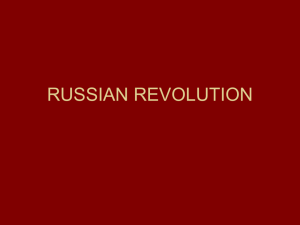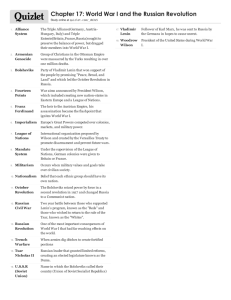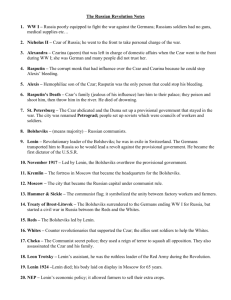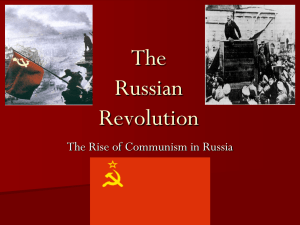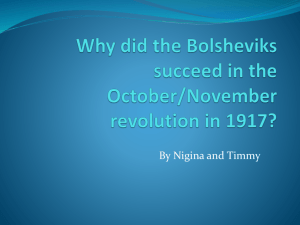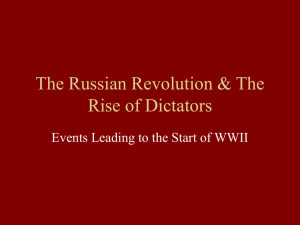Russian Revolution
advertisement
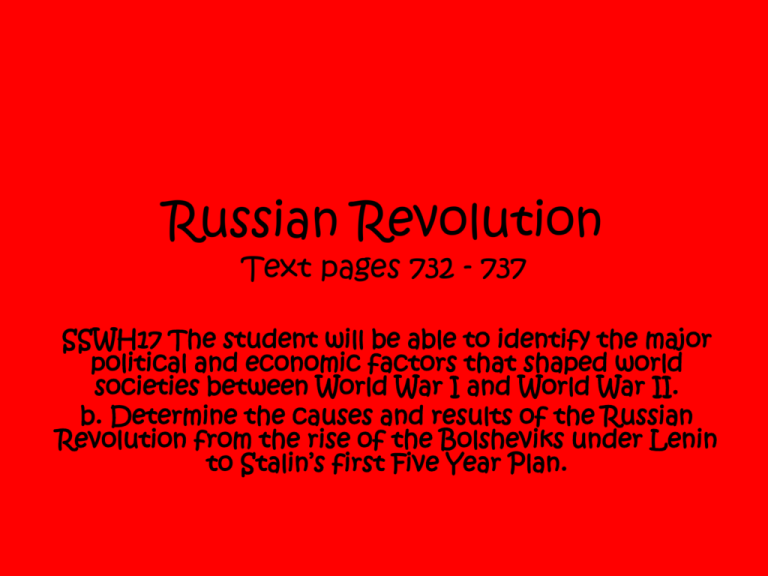
Russian Revolution Text pages 732 - 737 SSWH17 The student will be able to identify the major political and economic factors that shaped world societies between World War I and World War II. b. Determine the causes and results of the Russian Revolution from the rise of the Bolsheviks under Lenin to Stalin’s first Five Year Plan. Russia in WWI • Unprepared militarily and technologically for the total war of WWI. • No competent military leaders • Czar Nicholas II insisted on taking personal charge of the armed forces despite lack of ability or training • Inadequate supply of weapons for soldiers • Between 1914 and 1916, 2 million were killed and another 4-6 wounded or captured Beginnings of Upheaval • Czar Nicholas II was an autocratic leader who relied on army to hold up his regime. • Cut off from events by his willful and stubborn German wife, Alexandra who had fallen under the influence of Grigori Rasputin, who claimed to be a holy man. • As the leadership stumbled through a series of military and economic disasters, the Russian people grew more and more upset with the czarist regime. March Revolution • March 1917- working class women lead strikes in capital of Petrograd (formerly St. Petersburg) • Women striking because of bread rationing were factory workers demanding Peace & Bread • Strike shut down all factories in the city • Nicholas ordered troops to break up the crowds by shooting them if necessary • Soldiers refused and joined the demonstrators March Revolution Continued… • Duma (Legislature) established the provisional government and urged czar to step down • His abdication on March 15 ended the 300 year Romanov dynasty • Provisional government led by Alexander Kerensky • Decided to remain in WWI which did not make the peasants or the factory workers happy and they faced a challenge of authority from soviets Rise of Lenin • The Bolsheviks began as a small faction of the Marxist Party called the Russian Social Democrats • Leader of Bolsheviks Vladimir Ilyich Ulianov – V.I. Lenin • Party dedicated to revolution • Destroy the capitalist system • Lenin had been in exile but Germans shipped him to Russia to create disorder Bolsheviks Reflected the discontent of the people Promised an end to the war Redistribution of land to the peasants The transfer of factories & industries from capitalists to workers • Transfer of government from provisional government to the soviets • Slogans- Peace, Land, and Bread and All Power to the Soviets • • • • Bolsheviks Seize Power • By end of October, membership of Bolsheviks has skyrocketed • November 6, the Petrograd Soviet led by Leon Trotsky seizes the Winter Palace (the seat of the Provisional Govt.) • Lenin turned over power to the Congress of Soviets, which were really led by the Council of People’s Commissars headed by Lenin • Soon renamed themselves the communists • March 3, 1918- Treaty of Brest Litovsk gave up eastern Poland, Ukraine, Finland, and the Baltic Provinces to Germany to get out of WWI Civil War in Russia • Opposition to the Bolsheviks from groups loyal to the czar, liberals, and anti-Lenin socialists • 1918- 1921 • Communist (Red) Army fought against Whites (anti Bolsheviks- who were also supported by the Allies) • During this period, czar and his family were executed How did the Communists Triumph? • The Red Army was a well disciplined fighting force due to the organizational genius of Leon Trotsky. • Disunity of the anti-Communist forces • Communists sense of single purpose • Policy of war communism- used to ensure regular supplies for the Red Army • Red Secret Police- the Cheka- who began the reign of Terror Joseph Stalin • Lenin’s death in 1924 led to a struggle in the Politburo– the leading policy making body in the Communist party. • Joseph Stalin competed with Leon Trotsky for control of the party. • Stalinist Era marked the beginning of an economic, social, and political revolution in Russia that was more sweeping in its results than the revolutions of 1917. Stalin’s Five Year Plan • Ended NEP and set economic goals for five year periods • Purpose to transform Russia virtually overnight from an agricultural into an industrial nation • First Five Year Plan emphasized maximum production of capital goods and armaments • Quadrupled the production of heavy machinery and doubled oil production.



